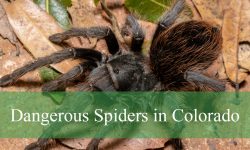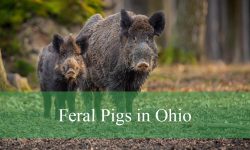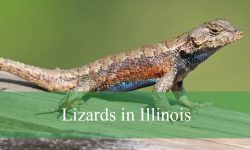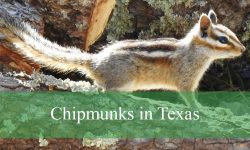Florida offers a wonderful chance to observe a wide variety of sparrows, especially during the cooler months when migratory species arrive. As someone who loves birds, especially sparrows, I find great joy in spotting their subtle markings, listening to their soft calls, and watching how they move through grasslands and shrubs. Sparrows in Florida may be small, but each one adds life and character to the landscape.
These birds can be found in many places across the state such as coastal marshes, open prairies, backyard gardens, and forest edges. Some are easy to spot like the bold House Sparrow while others such as Le Conte’s or Henslow’s Sparrow are more secretive and require patience and a sharp eye. No matter where you live in Florida, there is always a chance to see something new.
This guide covers 19 Sparrows in Florida complete with pictures and key identification details. With a little time and curiosity, you will start to notice just how many types are out there and how rewarding it is to get to know them.
Common Sparrows Found in Florida
House Sparrow (Passer domesticus)
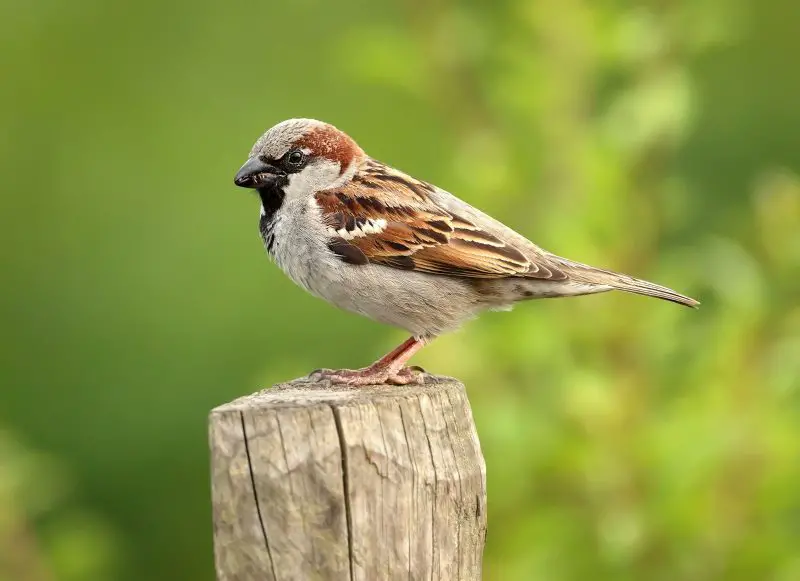
The House Sparrow is the most common sparrow species in Florida, easily recognizable by its chunky body, short tail, and stout bill. Adult males have a distinctive gray crown, black bib, and chestnut brown markings on the wings and back, while females and juveniles are mostly plain brown and gray. These birds measure about 6 to 7 inches in length and weigh around 24 to 39 grams, making them small but sturdy songbirds.
House Sparrows are very adaptable and often live close to humans, thriving in urban and suburban areas, including residential neighborhoods and commercial zones. Their call is a series of rapid, chirpy “cheep” sounds, often repeated in quick succession. Behaviorally, they are social birds that often form large flocks, especially outside the breeding season, and they are known to be aggressive toward other bird species when competing for food or nesting sites.
Their diet consists mainly of seeds and grains, but House Sparrows are opportunistic feeders and will consume insects and scraps of human food. They nest in cavities or structures like eaves, vents, and nest boxes, making Florida’s built environment ideal. This species is widespread across the state, found from coastal cities to inland towns, demonstrating remarkable tolerance for a variety of Florida’s climates and habitats.
Song Sparrow (Melospiza melodia)
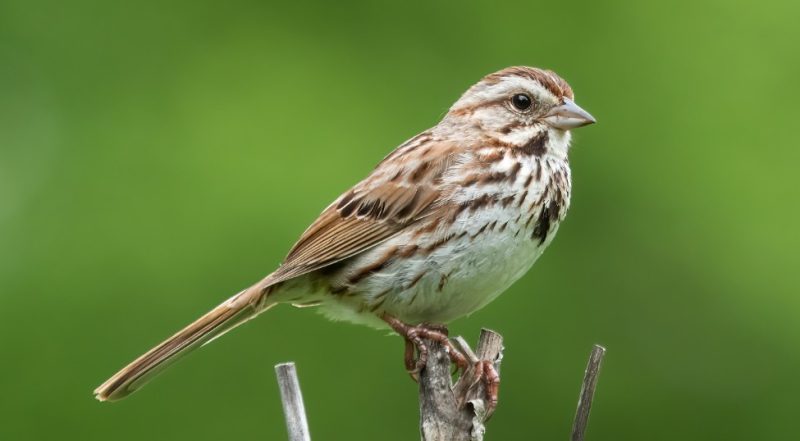
The Song Sparrow is a medium-sized sparrow with a distinctive pattern of brown and gray streaks across its body. It usually has a grayish face with a central dark spot on the chest, surrounded by heavily streaked brown plumage on the back and wings. Measuring about 5.5 to 7 inches long, these birds have a rich and melodious song, consisting of repeated, clear notes that vary between individuals.
Song Sparrows are commonly found in moist environments such as wetlands, marshes, and edges of lakes and ponds throughout Florida. They prefer dense shrubbery or brushy thickets for nesting and cover, where they can easily forage and hide from predators. Their behavior is often secretive and shy, staying low in dense vegetation and only briefly venturing into the open.
Their diet mainly includes seeds, berries, and insects, particularly during breeding season when they need more protein. The Song Sparrow is well-distributed across Florida, favoring areas with wet soils and dense plants, especially in the northern and central parts of the state, but it can be seen year-round in suitable habitats.
Savannah Sparrow (Passerculus sandwichensis)

The Savannah Sparrow is recognized by its streaked brown plumage with a notable yellow patch above the eye, giving it a subtle but unique look among sparrows. Its feathers are intricately patterned with dark and light streaks, providing excellent camouflage in its preferred open habitats. These birds are roughly 5 to 6 inches long and have a sharp, buzzy song that often includes a trill followed by high-pitched notes.
This sparrow is commonly found in Florida’s open grasslands, coastal marshes, and prairies, where it nests on the ground amid tall grasses or low shrubs. It is a shy species that tends to stay close to the ground, often running rather than flying short distances when disturbed. Their presence is especially notable during migration seasons, but some populations remain year-round in Florida’s suitable open habitats.
Savannah Sparrows feed mainly on seeds and insects, using their strong bills to forage on the ground. They play an important role in grassland ecosystems by helping control insect populations. This species is scattered throughout Florida, particularly in coastal areas and natural grasslands where their preferred habitat remains intact.
Chipping Sparrow (Spizella passerina)

The Chipping Sparrow is a small, slender bird easily identified by its bright rusty-red cap, black eye line, and pale grayish underparts. Adults typically measure about 4.5 to 5.5 inches in length, with a sharp, clear trill song that is often repeated for long periods, especially during the breeding season. Its overall appearance is neat and crisp, with well-defined head markings that contrast with its plain body.
This sparrow favors open woodlands, parks, and suburban areas with scattered trees and shrubs. In Florida, it is often seen in parks, yards, and other semi-open areas where it can find trees for nesting and open spaces for foraging. They are active and agile birds, frequently hopping along branches or the ground as they search for food.
The Chipping Sparrow’s diet consists primarily of seeds and insects, which it gathers mostly from the ground or low vegetation. It builds cup-shaped nests in tree branches or shrubs, typically in a sheltered spot. This species is common throughout Florida during spring and summer breeding seasons, often moving to more southern parts or coastal areas during winter.
White-throated Sparrow (Zonotrichia albicollis)
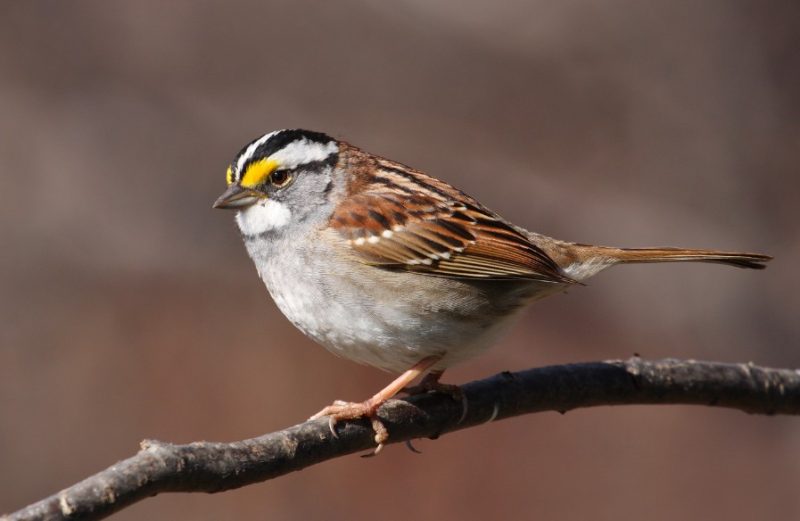
The White-throated Sparrow is easily recognized by its striking white throat patch, bold black-and-white head stripes, and a splash of yellow between the eyes and beak. It measures about 6.5 to 7 inches long, with a sturdy body and a rounded tail. Its song is a clear, whistled “Oh-sweet-Canada-Canada,” often heard in northern breeding ranges but sometimes vocalized during winter as well.
In Florida, this species is primarily a winter visitor, arriving in late fall and staying through early spring. It prefers wooded edges, dense thickets, and brushy areas near parks or gardens. These sparrows are often seen foraging in leaf litter or low shrubs, scratching the ground in search of food while remaining partially hidden in the undergrowth.
Their diet includes seeds, berries, and small insects, especially during winter months when natural food sources are scarce. White-throated Sparrows are most commonly observed throughout northern and central Florida during the cooler months, particularly in areas with dense vegetation that offers shelter and foraging opportunities.
Fox Sparrow (Passerella iliaca)
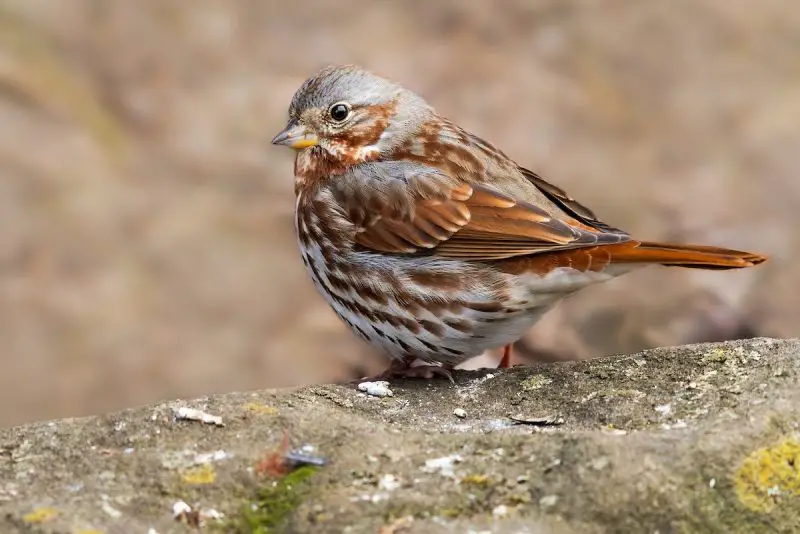
The Fox Sparrow is a large, stocky sparrow with rich reddish-brown plumage and bold dark streaks on its chest and sides that converge into a central spot. Named for its fox-like coloring, this bird measures around 7 to 8 inches in length and has a slightly rounded head with a thick bill. It produces a sweet, melodious song composed of varied whistles and trills.
This species appears in Florida primarily during winter migration, favoring thickets, forest edges, and overgrown areas with abundant cover. They often forage on the ground by vigorously scratching the leaf litter, exposing seeds and insects. Fox Sparrows are solitary or found in small groups, often hidden in dense vegetation.
Their diet consists mainly of seeds, berries, and insects, making them adaptable to seasonal food changes. In Florida, sightings are scattered but most likely to occur in the Panhandle and northern parts of the state, particularly in brushy or wooded habitats during colder months.
Swamp Sparrow (Melospiza georgiana)
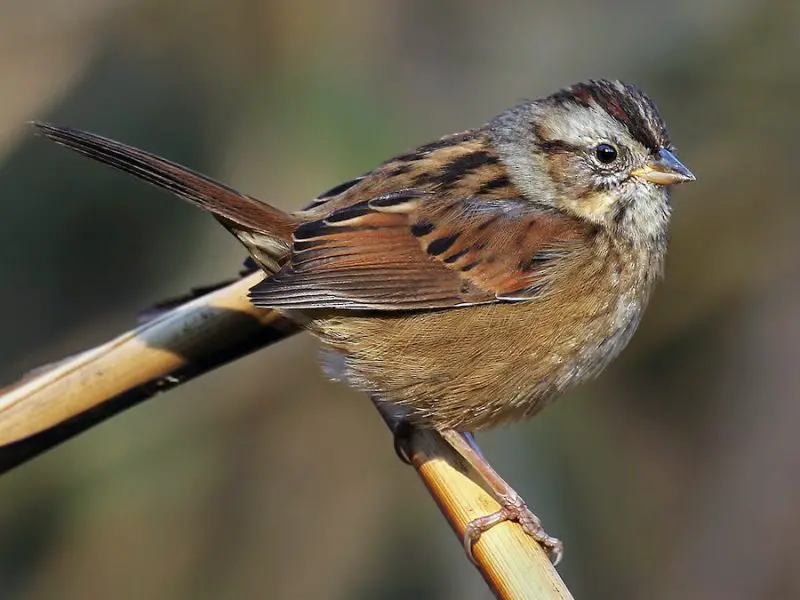
The Swamp Sparrow has a modest but distinct appearance, with grayish underparts, a reddish-brown crown, and warm brown wings with dark streaking. It is about 5 to 6 inches in length and is often heard giving a soft, musical trill that rises and falls in tone. Its subdued colors help it blend easily into its wetland surroundings.
As its name suggests, this sparrow thrives in swampy habitats, marshes, and wet meadows. In Florida, it is primarily a winter visitor, arriving in fall and frequenting low-lying, damp areas with tall grasses and reeds. Swamp Sparrows tend to stay low in vegetation and are more often heard than seen.
Their diet includes insects, spiders, seeds, and aquatic invertebrates. They forage slowly and methodically, often close to water. Swamp Sparrows are found throughout Florida in suitable wetlands during the cooler months, especially in wildlife refuges and marshy preserves.
Grasshopper Sparrow (Ammodramus savannarum)
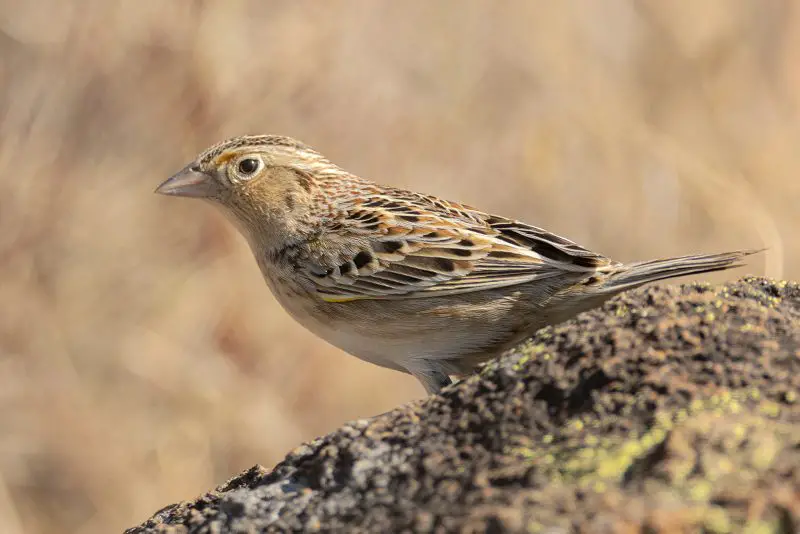
The Grasshopper Sparrow is a small, secretive bird with pale brown plumage, a flat head, and a short tail. Its most distinctive features are the orange-yellow patch above the eye and the faint streaking on its chest. It is named for its insect-like, buzzy song that resembles a grasshopper’s trill. Adults are around 4.5 to 5.5 inches long and are typically difficult to spot due to their excellent camouflage.
This species inhabits open fields, dry prairies, and native grasslands. In Florida, there are two subspecies: the Eastern Grasshopper Sparrow (A. s. pratensis), which visits during winter, and the endangered Florida Grasshopper Sparrow (A. s. floridanus), which resides year-round in the central prairies. The Florida subspecies is critically endangered due to habitat loss and limited range.
Grasshopper Sparrows feed on grass seeds, small insects, and larvae. They are ground-nesting birds that rely on undisturbed grasslands. Conservation areas and protected prairies in central Florida are crucial to the survival of the Florida subspecies, while the migratory Eastern type is more widespread during the cooler months.
Bachman’s Sparrow (Peucaea aestivalis)
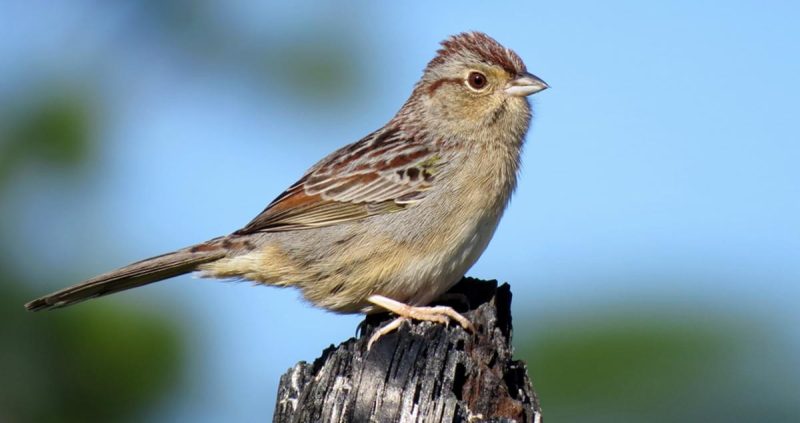
Bachman’s Sparrow is a shy, warm-colored sparrow with reddish-brown plumage, a pale gray chest, and a slightly rounded tail. Its face has subtle but soft markings that blend well with its body color. It measures about 5.5 to 6 inches long and is most known for its beautiful, whistled song followed by a trill, especially during early spring.
This sparrow prefers open pine woodlands and longleaf pine forests with sparse understory. In Florida, it is a year-round resident, particularly in the northern and central regions where fire-maintained pine ecosystems exist. Bachman’s Sparrows are elusive and usually stay hidden in grass or low shrubs, foraging quietly near the ground.
They feed on grass seeds, insects, and small arthropods. This species is considered near-threatened, with populations declining due to habitat destruction and fire suppression. In Florida, conservation efforts focus on preserving pine forests and controlled burns to maintain their preferred habitat, especially in places like Ocala National Forest and other managed conservation lands.
Seaside Sparrow (Ammospiza maritima)
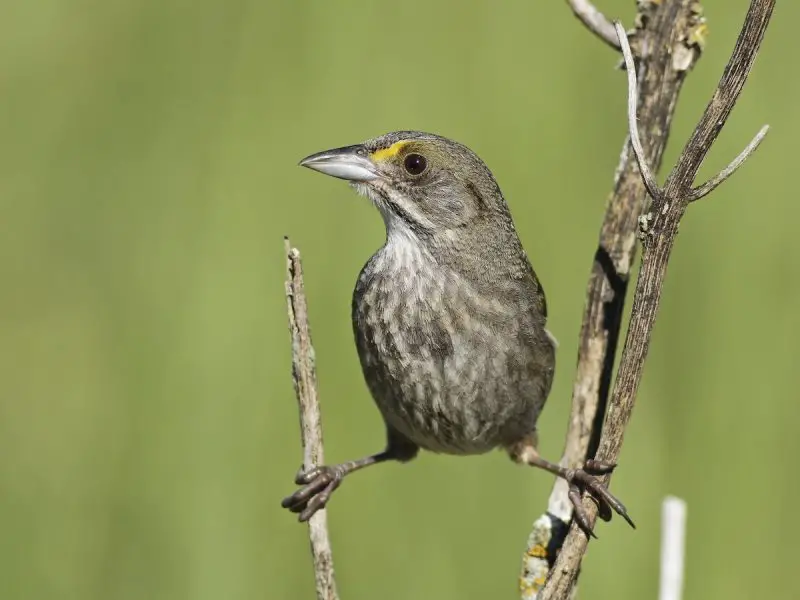
The Seaside Sparrow is a medium-sized marsh bird with olive-gray plumage, a dark cap, and a subtle yellow spot in front of the eyes. It measures about 5.5 to 6 inches long and has a short, thick bill adapted for foraging in salty environments. Its song is a raspy buzz, usually delivered from a perch above the marsh grasses. Though generally dull in color, its soft tones provide excellent camouflage in coastal habitats.
This sparrow inhabits saltmarshes along Florida’s coasts, particularly in the northern Gulf Coast and the Atlantic shoreline. It prefers tidal marshes with cordgrass and other salt-tolerant vegetation. Several subspecies of the Seaside Sparrow are recognized, including the now-extinct Cape Sable subspecies (A. m. mirabilis), once found only at the southern tip of Florida. These birds are year-round residents in the state’s suitable coastal wetlands.
Their diet includes insects, marine invertebrates, and seeds, which they find by walking and probing through marsh vegetation. Because of their reliance on healthy saltmarsh ecosystems, Seaside Sparrows are highly sensitive to habitat destruction, pollution, and sea level rise. Conservation of coastal marshlands in Florida is critical for maintaining their populations.
Clay-colored Sparrow (Spizella pallida)
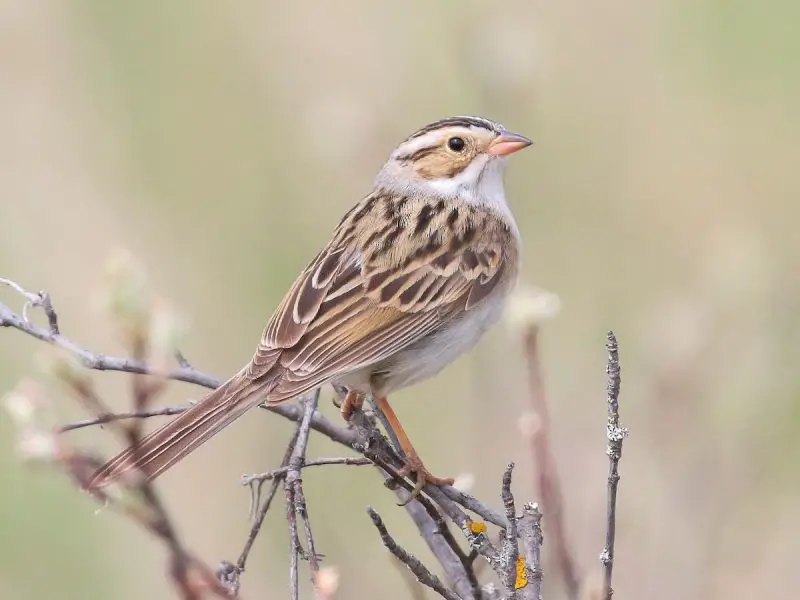
The Clay-colored Sparrow is a small, pale bird with clean gray cheeks, a buffy breast, and finely streaked brown upperparts. It also has a distinct dark line through the eye and a pale crown stripe. Measuring about 5.5 inches in length, its call is a dry, insect-like buzz, often given in open country during migration.
In Florida, the Clay-colored Sparrow is considered a rare winter migrant and is most often seen from late fall through early spring. It prefers weedy fields, grassy edges, and brushy areas during its brief visits. Unlike more common sparrows, this species does not breed in Florida and is only observed occasionally during migration or wintering periods.
Its diet mainly includes grass seeds and small insects, and it forages low in shrubs or on the ground. Although not a regular resident, birdwatchers in Florida sometimes spot it in open habitats, particularly in the Panhandle and central parts of the state during rare winter occurrences.
Henslow’s Sparrow (Centronyx henslowi)
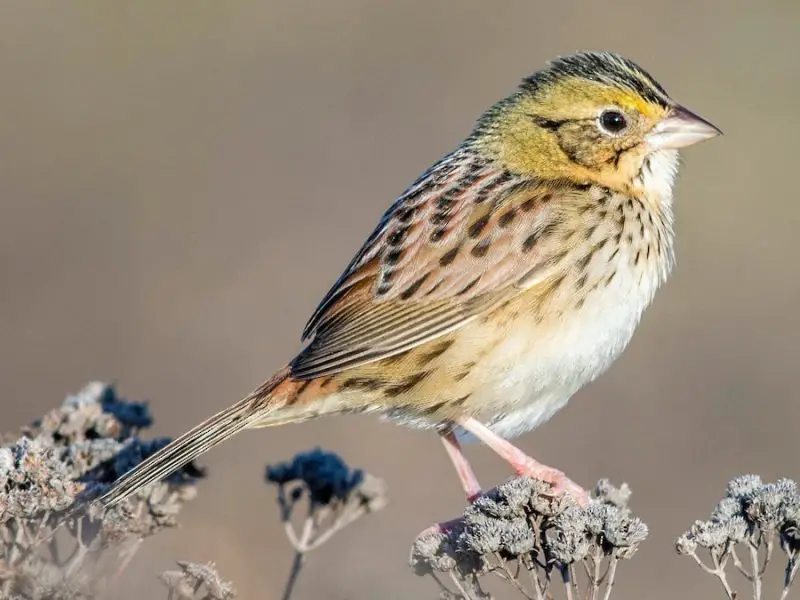
Henslow’s Sparrow is a secretive, small sparrow with streaky olive-brown upperparts, a greenish-tinged head, and pale underparts with dark streaks. It is about 4.5 to 5 inches long and has a flat head and short tail. Its song is a faint “tsi-lick” that is easily missed unless you’re listening closely in its grassy habitat.
This sparrow is extremely shy and prefers wet meadows, grassy fields, and old, overgrown pastures. In Florida, it is a rare and localized winter visitor, most often found in the Panhandle or parts of north-central Florida. It is difficult to spot due to its low profile and preference for dense, ground-level cover.
Henslow’s Sparrow feeds on seeds and small invertebrates, and it walks quietly through the grass while foraging. Due to habitat loss from agriculture and development, this species is considered near-threatened. Florida’s managed grasslands and conservation preserves provide some of the few remaining refuges during its winter stay.
Vesper Sparrow (Pooecetes gramineus)

The Vesper Sparrow is a relatively large sparrow with brown-streaked plumage, a white belly, and a distinctive white outer tail that flashes in flight. It also shows a pale eye ring and a subtle rufous patch on the shoulder. Adults measure about 5.5 to 6.5 inches long. Its name comes from its sweet, melodious evening song often heard at dusk.
This species prefers open fields, pastures, and sandy grasslands. In Florida, the Vesper Sparrow is primarily a winter resident, typically arriving in late fall and remaining until early spring. It tends to forage on the ground in open areas and is often seen perched on fences or low shrubs in rural landscapes.
Its diet includes grass seeds, grains, and insects, particularly beetles and caterpillars. The Vesper Sparrow’s preference for undisturbed open habitats makes it vulnerable to land-use changes. In Florida, it is most often found in agricultural fields, native prairies, and open pine flatwoods, especially in the northern and central regions.
Lark Sparrow (Chondestes grammacus)
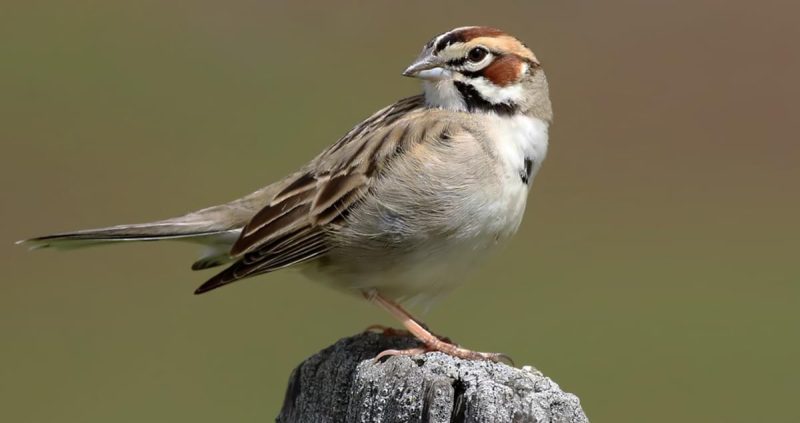
The Lark Sparrow is a large, boldly marked sparrow with chestnut cheek patches, a white belly, and a black central breast spot. Its striking facial pattern, with alternating black and white lines, makes it one of the most distinctive sparrows in North America. Adults measure around 6.5 to 7 inches in length, and their call is a rich, musical warble.
In Florida, the Lark Sparrow is an uncommon visitor, primarily during migration and sometimes in winter. It prefers open areas with sparse trees, grassy fields, and sandy clearings. Though rare, it can be found in the Panhandle and north-central Florida, especially where natural or semi-natural grasslands remain intact.
Its diet includes seeds, insects, and grains, and it forages on the ground or from low vegetation. The Lark Sparrow is a ground nester in its breeding range, but in Florida, it is usually observed resting or feeding. Sightings are most likely in dry, open spaces such as pastures, scrublands, or restored prairie habitats.
Le Conte’s Sparrow (Ammospiza leconteii)

Le Conte’s Sparrow is a small, secretive grassland bird with pale brown plumage, fine black streaks, and a soft yellowish-orange wash on the face and crown. It measures about 4.5 to 5 inches in length, with a short tail and a flat head that gives it a compact appearance. Its song is a thin, insect-like buzz, often hard to detect among tall grasses.
In Florida, Le Conte’s Sparrow is a rare winter visitor, typically found in moist meadows, grassy ditches, and wet prairies. It prefers habitats with dense ground cover where it can stay hidden, often flushing at the last moment when approached. Its elusive behavior and preference for thick grass make it difficult to observe, even in suitable locations.
This species feeds primarily on grass seeds and small insects, foraging low in vegetation. It is most likely to be seen in north and central Florida, particularly in protected prairie areas or wet grasslands. Due to habitat loss and its specialized preferences, this sparrow is considered of conservation concern.
Nelson’s Sparrow (Ammospiza nelsoni)
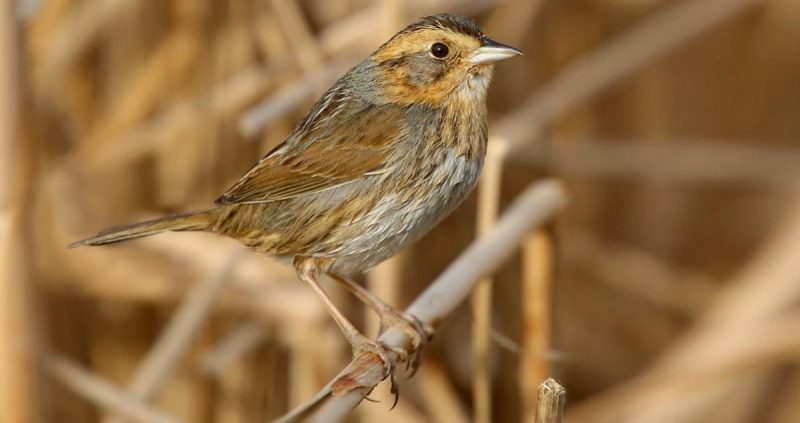
Nelson’s Sparrow is a beautifully patterned bird with a buff-orange face and breast, gray nape, and finely streaked brown back. It measures around 4.5 to 5 inches long and has a sharp, high-pitched call that resembles an insect buzz. The yellowish facial coloring and subtle streaking set it apart from other marsh sparrows.
This species is a migratory bird that winters along the coastal marshes of Florida, especially in the Panhandle and northern Gulf Coast. It inhabits salt and brackish marshes with dense grasses and reeds, often staying low to the ground. Nelson’s Sparrow is most often seen during fall and winter migration, carefully creeping through the vegetation.
Its diet includes small invertebrates, insects, and seeds, which it gathers by probing among the marsh grasses. Because of its dependence on tidal marshes, Nelson’s Sparrow faces threats from sea-level rise and habitat degradation. It is an uncommon but regular winter visitor in suitable coastal wetlands of Florida.
Baird’s Sparrow (Ammospiza bairdii)

Baird’s Sparrow is a handsome grassland species with buff-colored underparts, fine dark streaking on the chest, and a distinct pale central crown stripe. Adults are about 5 to 5.5 inches in length, and they have a short tail and rounded wings. The song of this sparrow is a soft, musical series of notes often described as sweet and wistful.
In Florida, Baird’s Sparrow is an extremely rare migrant, occasionally observed during fall or winter. It prefers open prairies and native grasslands, which are scarce in the state. Most sightings are isolated and limited to dry grassy fields or conservation areas during the non-breeding season.
Its diet consists of grass seeds and insects, and it forages low to the ground, usually hidden within tall grass. Due to its rarity and specific habitat needs, this species is a prized find for birders in Florida and is more commonly found in the central plains during migration and breeding.
Harris’s Sparrow (Zonotrichia querula)
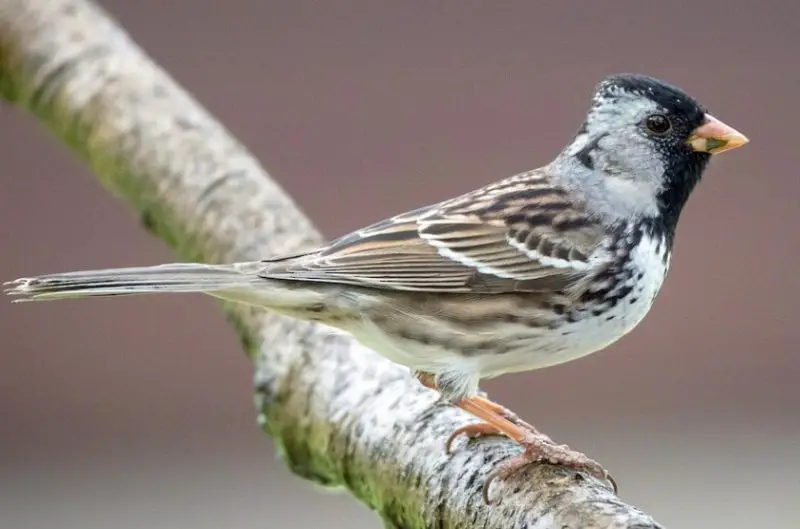
Harris’s Sparrow is the largest North American sparrow, notable for its bold black crown, face, and bib, which contrast with its pink bill and gray cheeks. Its back is streaked brown, and its underparts are pale gray. Adults measure about 7 to 7.5 inches long. Its song is a series of clear whistles and is most commonly heard in its northern breeding grounds.
In Florida, Harris’s Sparrow is a very rare winter visitor, sometimes appearing in open woodlands, brushy edges, or rural yards. It is more often seen in the central U.S. and Great Plains but occasionally strays eastward during migration or winter. Sightings in Florida are infrequent and usually involve lone individuals.
This species feeds on seeds, berries, and insects, foraging on or near the ground. Its bold facial pattern and large size make it easier to identify than most sparrows, though its rarity makes encounters in Florida highly unusual and exciting for birdwatchers.
White-crowned Sparrow (Zonotrichia leucophrys)
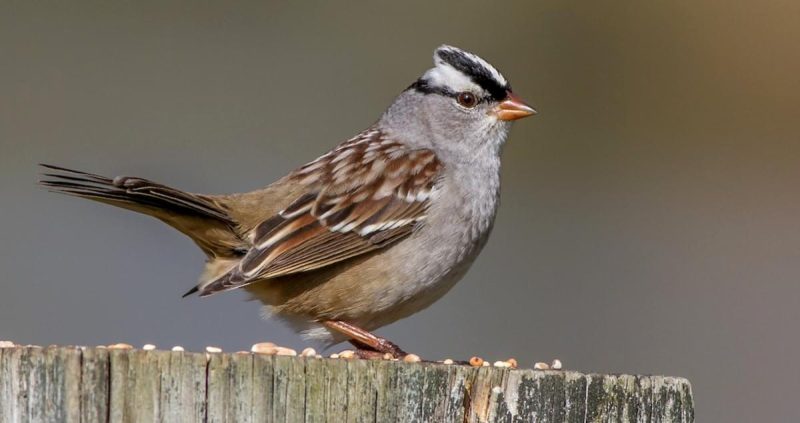
The White-crowned Sparrow is a striking bird with a crisp black-and-white striped crown, gray face and breast, and pink or yellowish bill. It measures about 6.5 to 7 inches in length and is known for its clear, whistled song and sharp “tseet” call. This species is one of the most easily recognized sparrows in North America.
In Florida, it is a regular winter migrant, found in brushy areas, forest edges, and suburban gardens. It typically arrives in late fall and departs by early spring. While foraging, it often scratches at the ground in leaf litter or low vegetation and may be seen in small flocks, sometimes mixed with other sparrows.
Its diet includes seeds, fruits, and insects, and it adapts well to a variety of semi-open habitats during migration. White-crowned Sparrows are most commonly found in northern and central Florida in winter, especially in protected areas with dense shrubs and open foraging grounds.
Best Time and Places to See Sparrows in Florida
The best time to observe sparrows in Florida is during the winter months, from October through March. During this period, a wide variety of migratory sparrows arrive from the north to spend the colder season in Florida’s milder climate. Species such as the White-throated Sparrow, Swamp Sparrow, and Savannah Sparrow are especially common during these months, making it a peak season for sparrow watching.
The best places to see sparrows in Florida include open grasslands, marshes, pine flatwoods, and coastal wetlands. Locations like Paynes Prairie Preserve State Park, St. Marks National Wildlife Refuge, and Apalachicola National Forest offer ideal habitats where both resident and migratory sparrows can be found. Dense vegetation, wet prairies, and brushy field edges are especially attractive to these birds for foraging and shelter.
For birders hoping to spot rarer species such as Le Conte’s Sparrow, Henslow’s Sparrow, or Nelson’s Sparrow, visiting early in the morning when birds are most active is recommended. Using a quiet approach and scanning low vegetation carefully will increase the chance of sightings. Florida’s diverse ecosystems and favorable climate make it one of the top states for sparrow observation during the winter season.


